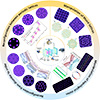| Nov 28, 2024 |
|
(Nanowerk News) Transport in photonic crystals (PCs) reveals a variety of fascinating phenomena, ranging from the photonic band gaps to topological edge states. One of the most attractive topics in this field is how to fabricate tunable PCs, allowing for real-time and flexibly control of the geometric configurations.
|
|
So far, a number of proposals for producing tunable PCs have been put forward such as thermal, mechanical, optofluidic, liquid crystal, and plasma systems. However, in a majority of photonic crystal systems, the ability to dynamically modulate structural parameters is limited to only a certain subset.
|
|
This restriction results in a reduced degree of adjustability and flexibility. It is essential to develop a robust fabrication strategy to create highly flexible photonic crystals for wide applications.
|
|
Recently, the research team of Professor Weili Fan at Hebei University, in collaboration with the research team of Professor Xiaoyong Hu at Peking University, have generated a tunable plasma photonic crystal (PPC) ‘kaleidoscope’ with rich diversity of geometric configurations in dielectric barrier discharge.
|
 |
| Plasma photonic ciystal ‘kaleidoscope’ with flexible control of topology and electromagnetism. (Image: Forntiers Journals)
|
|
The work is published in Frontiers of Optoelectronics (“Plasma photonic crystal ‘kaleidoscope’ with flexible control of topology and electromagnetism”).
|
|
The flexible control of PPCs, including the symmetry, dielectric constant, crystal orientation, lattice constant, and structures of scattering elements, have been realized. Different types of reconfigurations between lattices from periodic to periodic, from disordered to ordered, from non-topological to topological, and from striped to honeycomb Moiré lattices have been proposed.
|
|
The system provides a promising platform for yielding a PPC ‘kaleidoscope’ with the advantages of fewer equipment requirements, low cost, fast response, and more flexibility.
|
|
The work opens a new avenue to investigate tunable plasma metamaterials in a controllable way, which may inspire many future works such as integrated optical components, precision radiolocation, time-resolved imaging and sensing.
|


